A Global Systems Development Plan for Fonterra
VerifiedAdded on 2023/06/03
|15
|3988
|113
AI Summary
This article discusses the global systems development plan for Fonterra, a leading dairy exporter, and how multi-sourcing can help improve its services while reducing IT costs. It also explores different methodologies for global systems development, including the agile methodology.
Contribute Materials
Your contribution can guide someone’s learning journey. Share your
documents today.
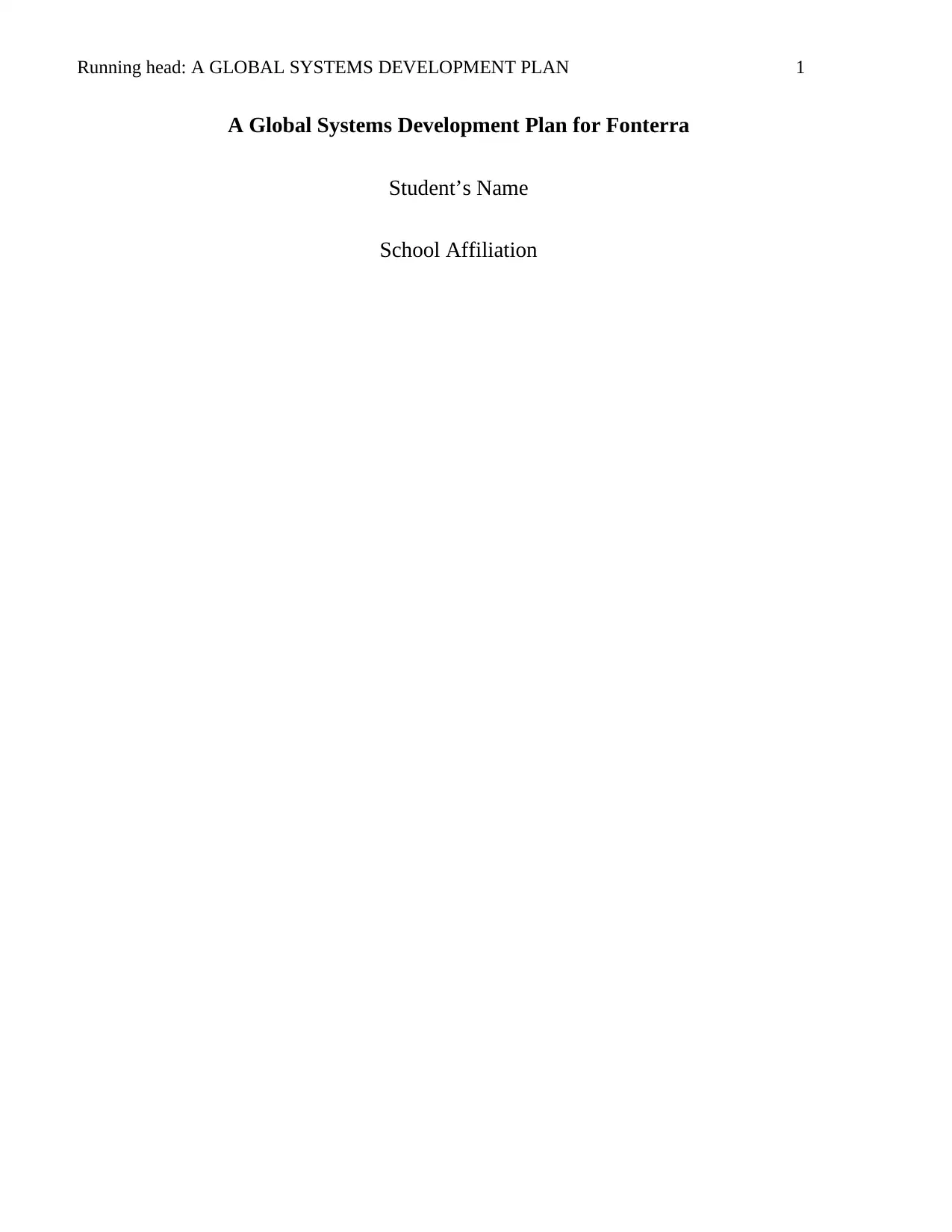
Running head: A GLOBAL SYSTEMS DEVELOPMENT PLAN 1
A Global Systems Development Plan for Fonterra
Student’s Name
School Affiliation
A Global Systems Development Plan for Fonterra
Student’s Name
School Affiliation
Secure Best Marks with AI Grader
Need help grading? Try our AI Grader for instant feedback on your assignments.
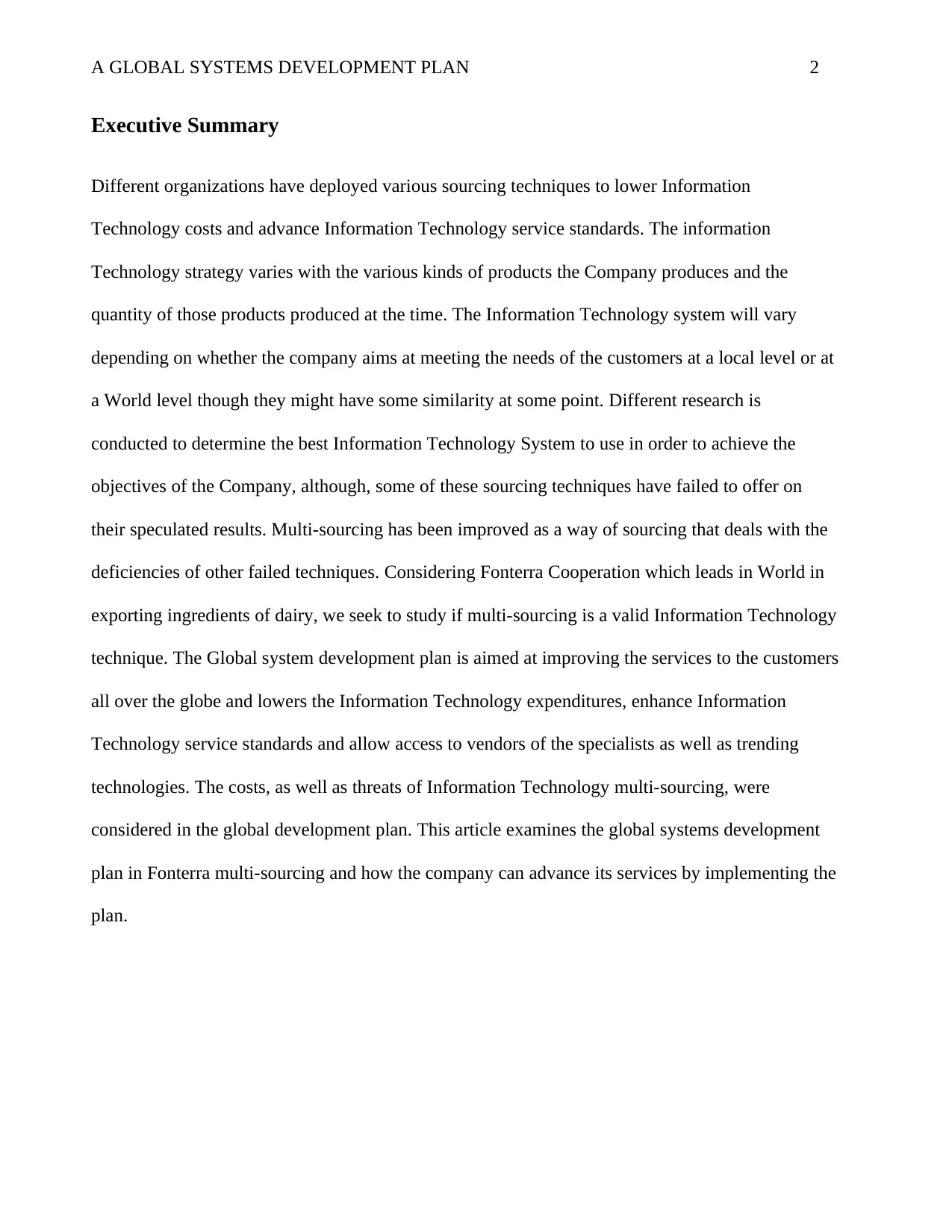
A GLOBAL SYSTEMS DEVELOPMENT PLAN 2
Executive Summary
Different organizations have deployed various sourcing techniques to lower Information
Technology costs and advance Information Technology service standards. The information
Technology strategy varies with the various kinds of products the Company produces and the
quantity of those products produced at the time. The Information Technology system will vary
depending on whether the company aims at meeting the needs of the customers at a local level or at
a World level though they might have some similarity at some point. Different research is
conducted to determine the best Information Technology System to use in order to achieve the
objectives of the Company, although, some of these sourcing techniques have failed to offer on
their speculated results. Multi-sourcing has been improved as a way of sourcing that deals with the
deficiencies of other failed techniques. Considering Fonterra Cooperation which leads in World in
exporting ingredients of dairy, we seek to study if multi-sourcing is a valid Information Technology
technique. The Global system development plan is aimed at improving the services to the customers
all over the globe and lowers the Information Technology expenditures, enhance Information
Technology service standards and allow access to vendors of the specialists as well as trending
technologies. The costs, as well as threats of Information Technology multi-sourcing, were
considered in the global development plan. This article examines the global systems development
plan in Fonterra multi-sourcing and how the company can advance its services by implementing the
plan.
Executive Summary
Different organizations have deployed various sourcing techniques to lower Information
Technology costs and advance Information Technology service standards. The information
Technology strategy varies with the various kinds of products the Company produces and the
quantity of those products produced at the time. The Information Technology system will vary
depending on whether the company aims at meeting the needs of the customers at a local level or at
a World level though they might have some similarity at some point. Different research is
conducted to determine the best Information Technology System to use in order to achieve the
objectives of the Company, although, some of these sourcing techniques have failed to offer on
their speculated results. Multi-sourcing has been improved as a way of sourcing that deals with the
deficiencies of other failed techniques. Considering Fonterra Cooperation which leads in World in
exporting ingredients of dairy, we seek to study if multi-sourcing is a valid Information Technology
technique. The Global system development plan is aimed at improving the services to the customers
all over the globe and lowers the Information Technology expenditures, enhance Information
Technology service standards and allow access to vendors of the specialists as well as trending
technologies. The costs, as well as threats of Information Technology multi-sourcing, were
considered in the global development plan. This article examines the global systems development
plan in Fonterra multi-sourcing and how the company can advance its services by implementing the
plan.
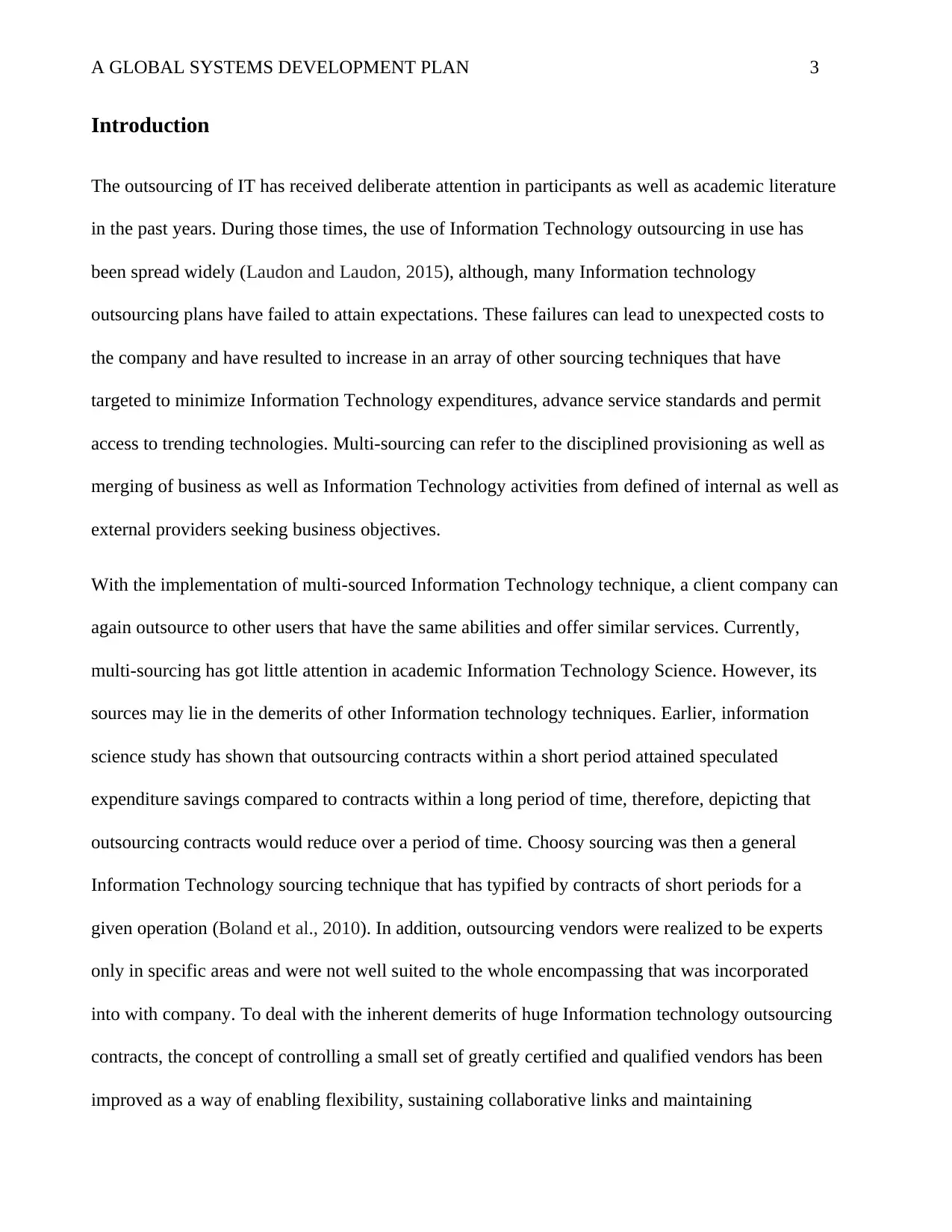
A GLOBAL SYSTEMS DEVELOPMENT PLAN 3
Introduction
The outsourcing of IT has received deliberate attention in participants as well as academic literature
in the past years. During those times, the use of Information Technology outsourcing in use has
been spread widely (Laudon and Laudon, 2015), although, many Information technology
outsourcing plans have failed to attain expectations. These failures can lead to unexpected costs to
the company and have resulted to increase in an array of other sourcing techniques that have
targeted to minimize Information Technology expenditures, advance service standards and permit
access to trending technologies. Multi-sourcing can refer to the disciplined provisioning as well as
merging of business as well as Information Technology activities from defined of internal as well as
external providers seeking business objectives.
With the implementation of multi-sourced Information Technology technique, a client company can
again outsource to other users that have the same abilities and offer similar services. Currently,
multi-sourcing has got little attention in academic Information Technology Science. However, its
sources may lie in the demerits of other Information technology techniques. Earlier, information
science study has shown that outsourcing contracts within a short period attained speculated
expenditure savings compared to contracts within a long period of time, therefore, depicting that
outsourcing contracts would reduce over a period of time. Choosy sourcing was then a general
Information Technology sourcing technique that has typified by contracts of short periods for a
given operation (Boland et al., 2010). In addition, outsourcing vendors were realized to be experts
only in specific areas and were not well suited to the whole encompassing that was incorporated
into with company. To deal with the inherent demerits of huge Information technology outsourcing
contracts, the concept of controlling a small set of greatly certified and qualified vendors has been
improved as a way of enabling flexibility, sustaining collaborative links and maintaining
Introduction
The outsourcing of IT has received deliberate attention in participants as well as academic literature
in the past years. During those times, the use of Information Technology outsourcing in use has
been spread widely (Laudon and Laudon, 2015), although, many Information technology
outsourcing plans have failed to attain expectations. These failures can lead to unexpected costs to
the company and have resulted to increase in an array of other sourcing techniques that have
targeted to minimize Information Technology expenditures, advance service standards and permit
access to trending technologies. Multi-sourcing can refer to the disciplined provisioning as well as
merging of business as well as Information Technology activities from defined of internal as well as
external providers seeking business objectives.
With the implementation of multi-sourced Information Technology technique, a client company can
again outsource to other users that have the same abilities and offer similar services. Currently,
multi-sourcing has got little attention in academic Information Technology Science. However, its
sources may lie in the demerits of other Information technology techniques. Earlier, information
science study has shown that outsourcing contracts within a short period attained speculated
expenditure savings compared to contracts within a long period of time, therefore, depicting that
outsourcing contracts would reduce over a period of time. Choosy sourcing was then a general
Information Technology sourcing technique that has typified by contracts of short periods for a
given operation (Boland et al., 2010). In addition, outsourcing vendors were realized to be experts
only in specific areas and were not well suited to the whole encompassing that was incorporated
into with company. To deal with the inherent demerits of huge Information technology outsourcing
contracts, the concept of controlling a small set of greatly certified and qualified vendors has been
improved as a way of enabling flexibility, sustaining collaborative links and maintaining
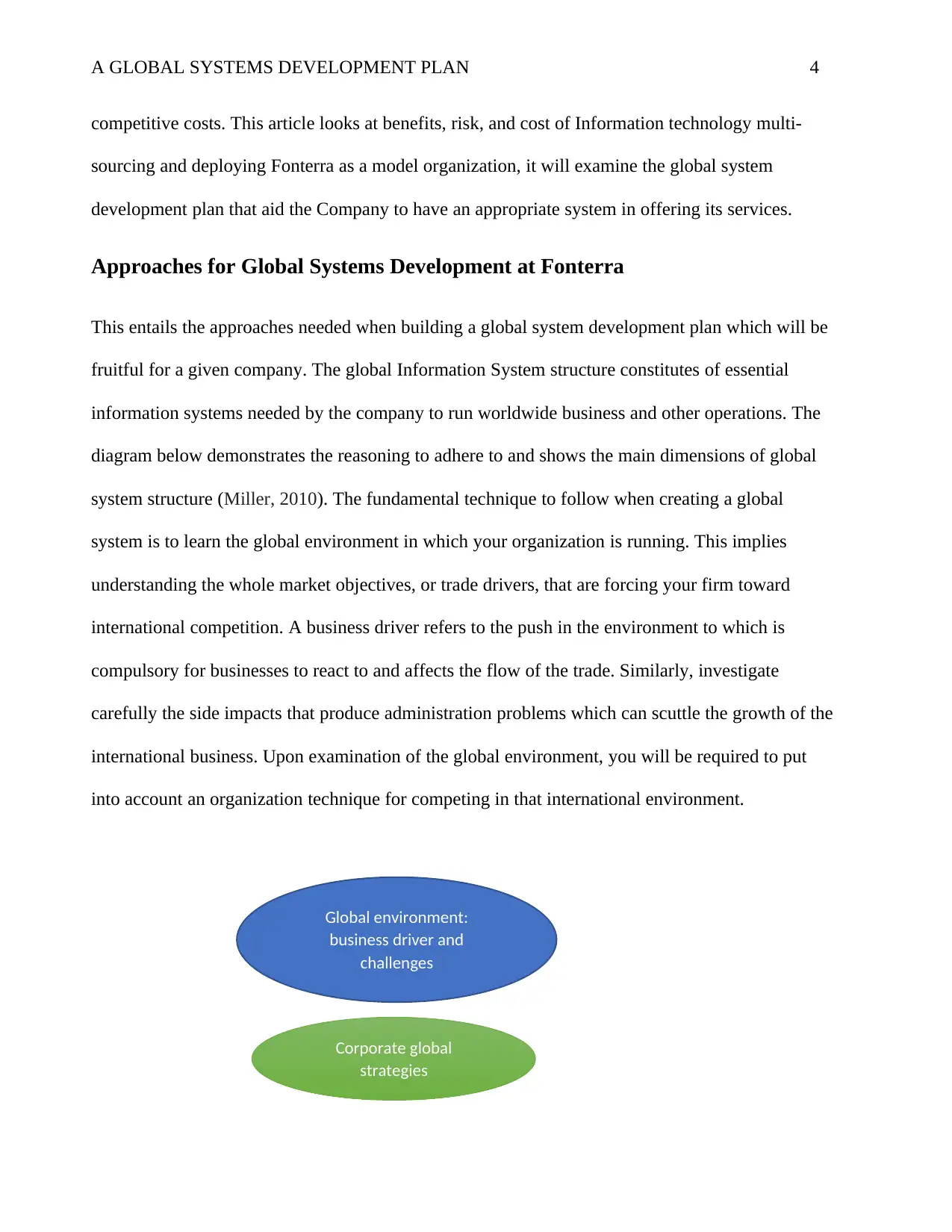
A GLOBAL SYSTEMS DEVELOPMENT PLAN 4
competitive costs. This article looks at benefits, risk, and cost of Information technology multi-
sourcing and deploying Fonterra as a model organization, it will examine the global system
development plan that aid the Company to have an appropriate system in offering its services.
Approaches for Global Systems Development at Fonterra
This entails the approaches needed when building a global system development plan which will be
fruitful for a given company. The global Information System structure constitutes of essential
information systems needed by the company to run worldwide business and other operations. The
diagram below demonstrates the reasoning to adhere to and shows the main dimensions of global
system structure (Miller, 2010). The fundamental technique to follow when creating a global
system is to learn the global environment in which your organization is running. This implies
understanding the whole market objectives, or trade drivers, that are forcing your firm toward
international competition. A business driver refers to the push in the environment to which is
compulsory for businesses to react to and affects the flow of the trade. Similarly, investigate
carefully the side impacts that produce administration problems which can scuttle the growth of the
international business. Upon examination of the global environment, you will be required to put
into account an organization technique for competing in that international environment.
Global environment:
business driver and
challenges
Corporate global
strategies
competitive costs. This article looks at benefits, risk, and cost of Information technology multi-
sourcing and deploying Fonterra as a model organization, it will examine the global system
development plan that aid the Company to have an appropriate system in offering its services.
Approaches for Global Systems Development at Fonterra
This entails the approaches needed when building a global system development plan which will be
fruitful for a given company. The global Information System structure constitutes of essential
information systems needed by the company to run worldwide business and other operations. The
diagram below demonstrates the reasoning to adhere to and shows the main dimensions of global
system structure (Miller, 2010). The fundamental technique to follow when creating a global
system is to learn the global environment in which your organization is running. This implies
understanding the whole market objectives, or trade drivers, that are forcing your firm toward
international competition. A business driver refers to the push in the environment to which is
compulsory for businesses to react to and affects the flow of the trade. Similarly, investigate
carefully the side impacts that produce administration problems which can scuttle the growth of the
international business. Upon examination of the global environment, you will be required to put
into account an organization technique for competing in that international environment.
Global environment:
business driver and
challenges
Corporate global
strategies
Secure Best Marks with AI Grader
Need help grading? Try our AI Grader for instant feedback on your assignments.

A GLOBAL SYSTEMS DEVELOPMENT PLAN 5
After you have set a technique, it is the moment to consider how to structure your firm so that you
can meet your objectives. Secondly, you consider the administrative affairs in running your
technique and making the company structure come real and the main issue will be the make of the
trade procedures (Kent, 2015)). How can you realize and control user needs? How do you introduce
change in local stations to match the global needs? How you can redesign on an international scale,
how you can organize systems creation? Finally, consider the Information Technology platform in
order to match the global markets.
To begin with, a system refers to any Information Technology element such as hardware and
software. Every system goes via growth lifecycle from first planning through to configuration.
Some methodologies offer the relevant framework to direct the challenging as well as a complex
procedure with an objective to avoid severe mistakes and expedite growth, all which have the
common aim of software or physical based structure via stages (Miller, 2010). A system growth life
Organization structure
Management and
business processes
Technology
platform
After you have set a technique, it is the moment to consider how to structure your firm so that you
can meet your objectives. Secondly, you consider the administrative affairs in running your
technique and making the company structure come real and the main issue will be the make of the
trade procedures (Kent, 2015)). How can you realize and control user needs? How do you introduce
change in local stations to match the global needs? How you can redesign on an international scale,
how you can organize systems creation? Finally, consider the Information Technology platform in
order to match the global markets.
To begin with, a system refers to any Information Technology element such as hardware and
software. Every system goes via growth lifecycle from first planning through to configuration.
Some methodologies offer the relevant framework to direct the challenging as well as a complex
procedure with an objective to avoid severe mistakes and expedite growth, all which have the
common aim of software or physical based structure via stages (Miller, 2010). A system growth life
Organization structure
Management and
business processes
Technology
platform
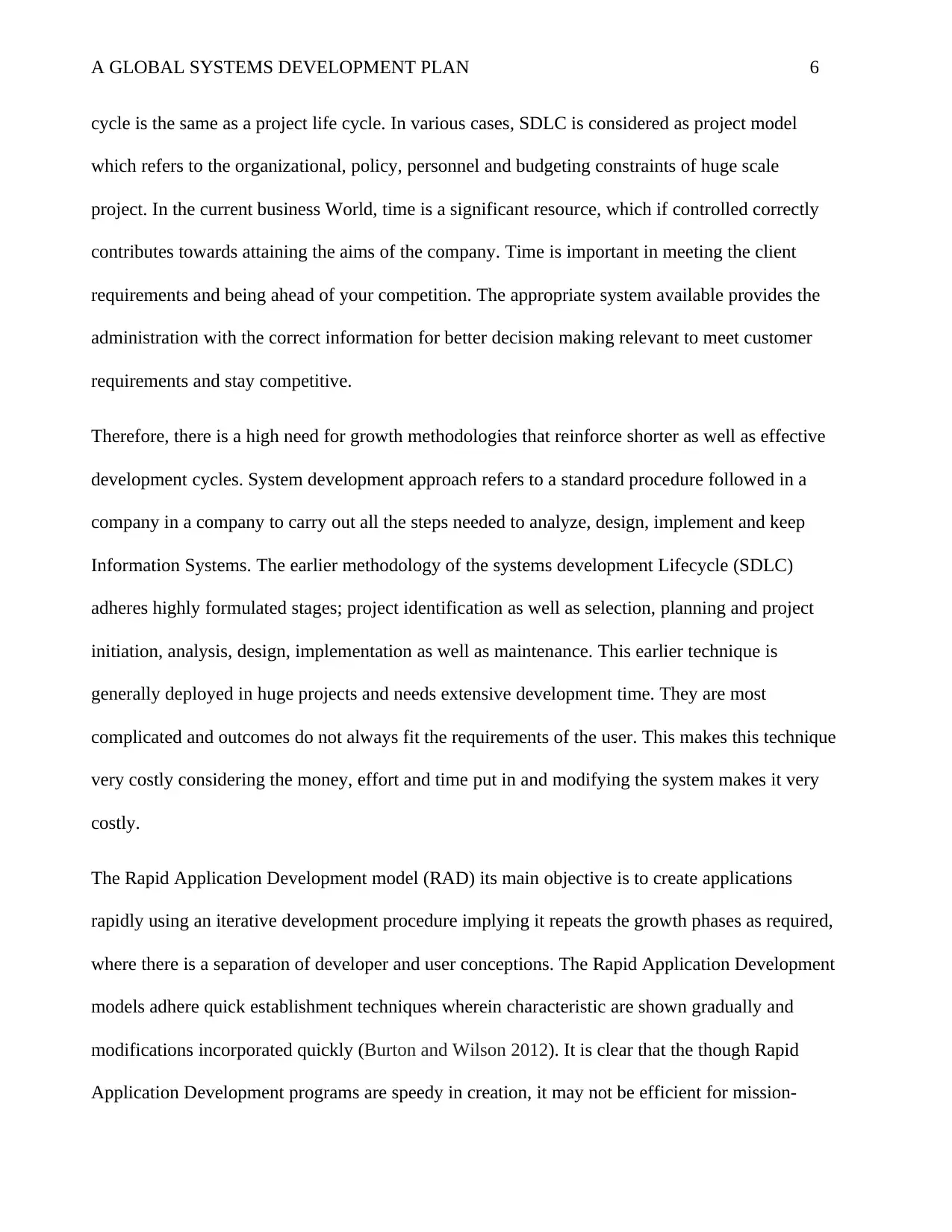
A GLOBAL SYSTEMS DEVELOPMENT PLAN 6
cycle is the same as a project life cycle. In various cases, SDLC is considered as project model
which refers to the organizational, policy, personnel and budgeting constraints of huge scale
project. In the current business World, time is a significant resource, which if controlled correctly
contributes towards attaining the aims of the company. Time is important in meeting the client
requirements and being ahead of your competition. The appropriate system available provides the
administration with the correct information for better decision making relevant to meet customer
requirements and stay competitive.
Therefore, there is a high need for growth methodologies that reinforce shorter as well as effective
development cycles. System development approach refers to a standard procedure followed in a
company in a company to carry out all the steps needed to analyze, design, implement and keep
Information Systems. The earlier methodology of the systems development Lifecycle (SDLC)
adheres highly formulated stages; project identification as well as selection, planning and project
initiation, analysis, design, implementation as well as maintenance. This earlier technique is
generally deployed in huge projects and needs extensive development time. They are most
complicated and outcomes do not always fit the requirements of the user. This makes this technique
very costly considering the money, effort and time put in and modifying the system makes it very
costly.
The Rapid Application Development model (RAD) its main objective is to create applications
rapidly using an iterative development procedure implying it repeats the growth phases as required,
where there is a separation of developer and user conceptions. The Rapid Application Development
models adhere quick establishment techniques wherein characteristic are shown gradually and
modifications incorporated quickly (Burton and Wilson 2012). It is clear that the though Rapid
Application Development programs are speedy in creation, it may not be efficient for mission-
cycle is the same as a project life cycle. In various cases, SDLC is considered as project model
which refers to the organizational, policy, personnel and budgeting constraints of huge scale
project. In the current business World, time is a significant resource, which if controlled correctly
contributes towards attaining the aims of the company. Time is important in meeting the client
requirements and being ahead of your competition. The appropriate system available provides the
administration with the correct information for better decision making relevant to meet customer
requirements and stay competitive.
Therefore, there is a high need for growth methodologies that reinforce shorter as well as effective
development cycles. System development approach refers to a standard procedure followed in a
company in a company to carry out all the steps needed to analyze, design, implement and keep
Information Systems. The earlier methodology of the systems development Lifecycle (SDLC)
adheres highly formulated stages; project identification as well as selection, planning and project
initiation, analysis, design, implementation as well as maintenance. This earlier technique is
generally deployed in huge projects and needs extensive development time. They are most
complicated and outcomes do not always fit the requirements of the user. This makes this technique
very costly considering the money, effort and time put in and modifying the system makes it very
costly.
The Rapid Application Development model (RAD) its main objective is to create applications
rapidly using an iterative development procedure implying it repeats the growth phases as required,
where there is a separation of developer and user conceptions. The Rapid Application Development
models adhere quick establishment techniques wherein characteristic are shown gradually and
modifications incorporated quickly (Burton and Wilson 2012). It is clear that the though Rapid
Application Development programs are speedy in creation, it may not be efficient for mission-

A GLOBAL SYSTEMS DEVELOPMENT PLAN 7
sensitive programs with the complicated mechanism as well as the large volume of data or if the
structure is not clear and equipment deployed are complex. The landscape of creation of software
changes often although over years the main strategy in administrating software is reducing the
period of development while increasing the progress.
The Rapid Application Development has got not well-set stages compared to SDLC which is a
structured technique and has got well-defined steps. In Rapid Application, creation can be perceived
as the technique while the SDLC adheres to the predictive, rigid as well as inflexible approach for
application creation. The deployment of automated Rapid Application Development equipment and
strategies allow faster as well as simpler prototypes that are then deployed to create the last product
compared to SDLC where prototyping is hard and needs more periods of time as well as effort. In
Rapid Application Development it is irrelevant to be aware of all the needs beforehand while in
SDLC all the needs should be known before initiating the plan due to the hardness of the models.
The Rapid Application Development allows accommodation of modifications because of the
sequential character of models. The Rapid Application Development allows the extensive user
response resulting to maximum user satisfaction as well as the better standard of the final software
while the SDLC approach has limited user response. The Rapid Application Development entails
minimal documentation while the SDLC allows the stringent as well as an extensive recording of
the whole process. The Rapid Application Development allows the assignment of individual
modules whereas the SDLC is employed where projects have longer scheduled and where the
budge do not permit the employment of expensive as well as a stronger tool. The Rapid Application
Development is commonly referred to programs with a short period of time and budget huge
enough to cater for the automated tools as well as approaches. The SDLC is deployed for programs
which need a longer period of time and does not permit the use costly as powerful equipment. The
sensitive programs with the complicated mechanism as well as the large volume of data or if the
structure is not clear and equipment deployed are complex. The landscape of creation of software
changes often although over years the main strategy in administrating software is reducing the
period of development while increasing the progress.
The Rapid Application Development has got not well-set stages compared to SDLC which is a
structured technique and has got well-defined steps. In Rapid Application, creation can be perceived
as the technique while the SDLC adheres to the predictive, rigid as well as inflexible approach for
application creation. The deployment of automated Rapid Application Development equipment and
strategies allow faster as well as simpler prototypes that are then deployed to create the last product
compared to SDLC where prototyping is hard and needs more periods of time as well as effort. In
Rapid Application Development it is irrelevant to be aware of all the needs beforehand while in
SDLC all the needs should be known before initiating the plan due to the hardness of the models.
The Rapid Application Development allows accommodation of modifications because of the
sequential character of models. The Rapid Application Development allows the extensive user
response resulting to maximum user satisfaction as well as the better standard of the final software
while the SDLC approach has limited user response. The Rapid Application Development entails
minimal documentation while the SDLC allows the stringent as well as an extensive recording of
the whole process. The Rapid Application Development allows the assignment of individual
modules whereas the SDLC is employed where projects have longer scheduled and where the
budge do not permit the employment of expensive as well as a stronger tool. The Rapid Application
Development is commonly referred to programs with a short period of time and budget huge
enough to cater for the automated tools as well as approaches. The SDLC is deployed for programs
which need a longer period of time and does not permit the use costly as powerful equipment. The
Paraphrase This Document
Need a fresh take? Get an instant paraphrase of this document with our AI Paraphraser
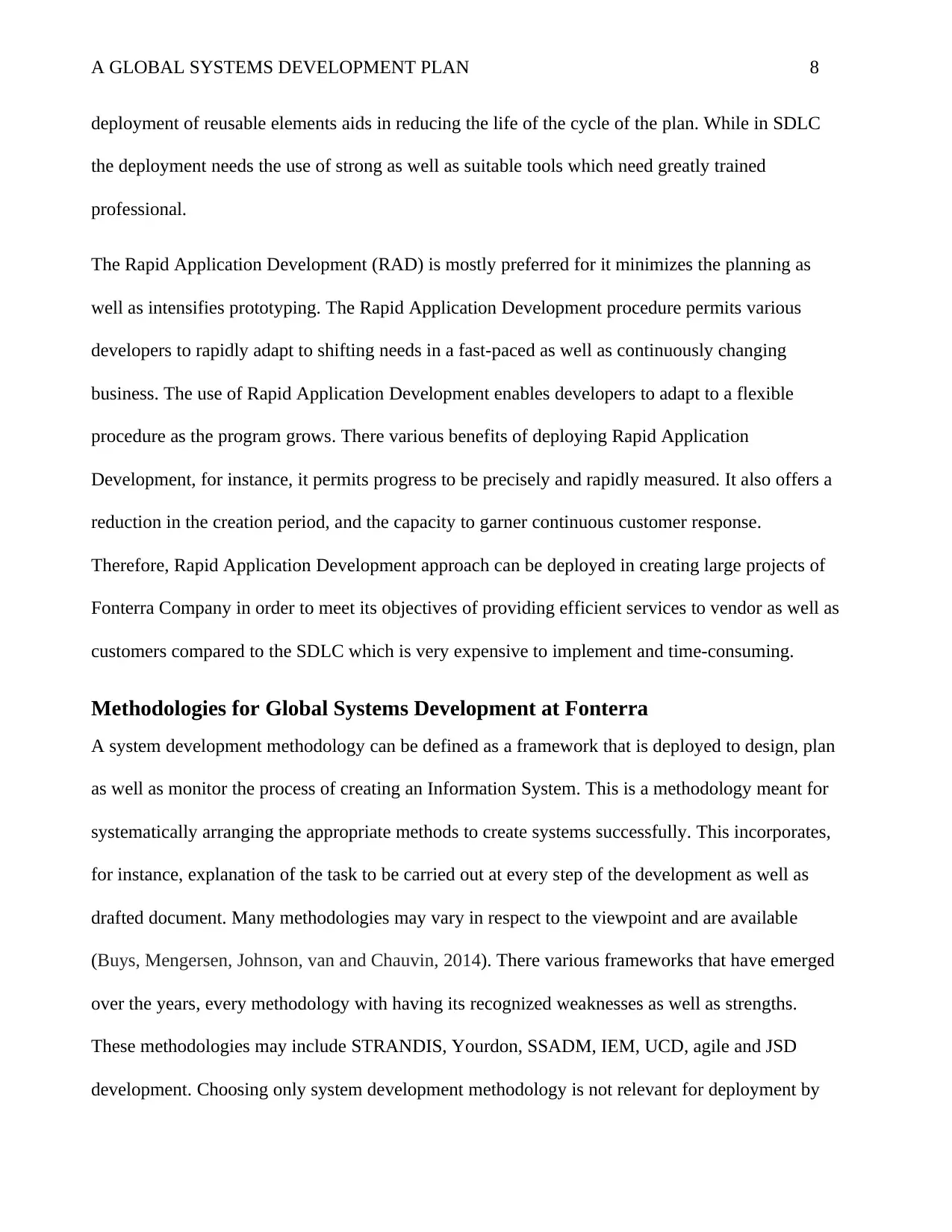
A GLOBAL SYSTEMS DEVELOPMENT PLAN 8
deployment of reusable elements aids in reducing the life of the cycle of the plan. While in SDLC
the deployment needs the use of strong as well as suitable tools which need greatly trained
professional.
The Rapid Application Development (RAD) is mostly preferred for it minimizes the planning as
well as intensifies prototyping. The Rapid Application Development procedure permits various
developers to rapidly adapt to shifting needs in a fast-paced as well as continuously changing
business. The use of Rapid Application Development enables developers to adapt to a flexible
procedure as the program grows. There various benefits of deploying Rapid Application
Development, for instance, it permits progress to be precisely and rapidly measured. It also offers a
reduction in the creation period, and the capacity to garner continuous customer response.
Therefore, Rapid Application Development approach can be deployed in creating large projects of
Fonterra Company in order to meet its objectives of providing efficient services to vendor as well as
customers compared to the SDLC which is very expensive to implement and time-consuming.
Methodologies for Global Systems Development at Fonterra
A system development methodology can be defined as a framework that is deployed to design, plan
as well as monitor the process of creating an Information System. This is a methodology meant for
systematically arranging the appropriate methods to create systems successfully. This incorporates,
for instance, explanation of the task to be carried out at every step of the development as well as
drafted document. Many methodologies may vary in respect to the viewpoint and are available
(Buys, Mengersen, Johnson, van and Chauvin, 2014). There various frameworks that have emerged
over the years, every methodology with having its recognized weaknesses as well as strengths.
These methodologies may include STRANDIS, Yourdon, SSADM, IEM, UCD, agile and JSD
development. Choosing only system development methodology is not relevant for deployment by
deployment of reusable elements aids in reducing the life of the cycle of the plan. While in SDLC
the deployment needs the use of strong as well as suitable tools which need greatly trained
professional.
The Rapid Application Development (RAD) is mostly preferred for it minimizes the planning as
well as intensifies prototyping. The Rapid Application Development procedure permits various
developers to rapidly adapt to shifting needs in a fast-paced as well as continuously changing
business. The use of Rapid Application Development enables developers to adapt to a flexible
procedure as the program grows. There various benefits of deploying Rapid Application
Development, for instance, it permits progress to be precisely and rapidly measured. It also offers a
reduction in the creation period, and the capacity to garner continuous customer response.
Therefore, Rapid Application Development approach can be deployed in creating large projects of
Fonterra Company in order to meet its objectives of providing efficient services to vendor as well as
customers compared to the SDLC which is very expensive to implement and time-consuming.
Methodologies for Global Systems Development at Fonterra
A system development methodology can be defined as a framework that is deployed to design, plan
as well as monitor the process of creating an Information System. This is a methodology meant for
systematically arranging the appropriate methods to create systems successfully. This incorporates,
for instance, explanation of the task to be carried out at every step of the development as well as
drafted document. Many methodologies may vary in respect to the viewpoint and are available
(Buys, Mengersen, Johnson, van and Chauvin, 2014). There various frameworks that have emerged
over the years, every methodology with having its recognized weaknesses as well as strengths.
These methodologies may include STRANDIS, Yourdon, SSADM, IEM, UCD, agile and JSD
development. Choosing only system development methodology is not relevant for deployment by
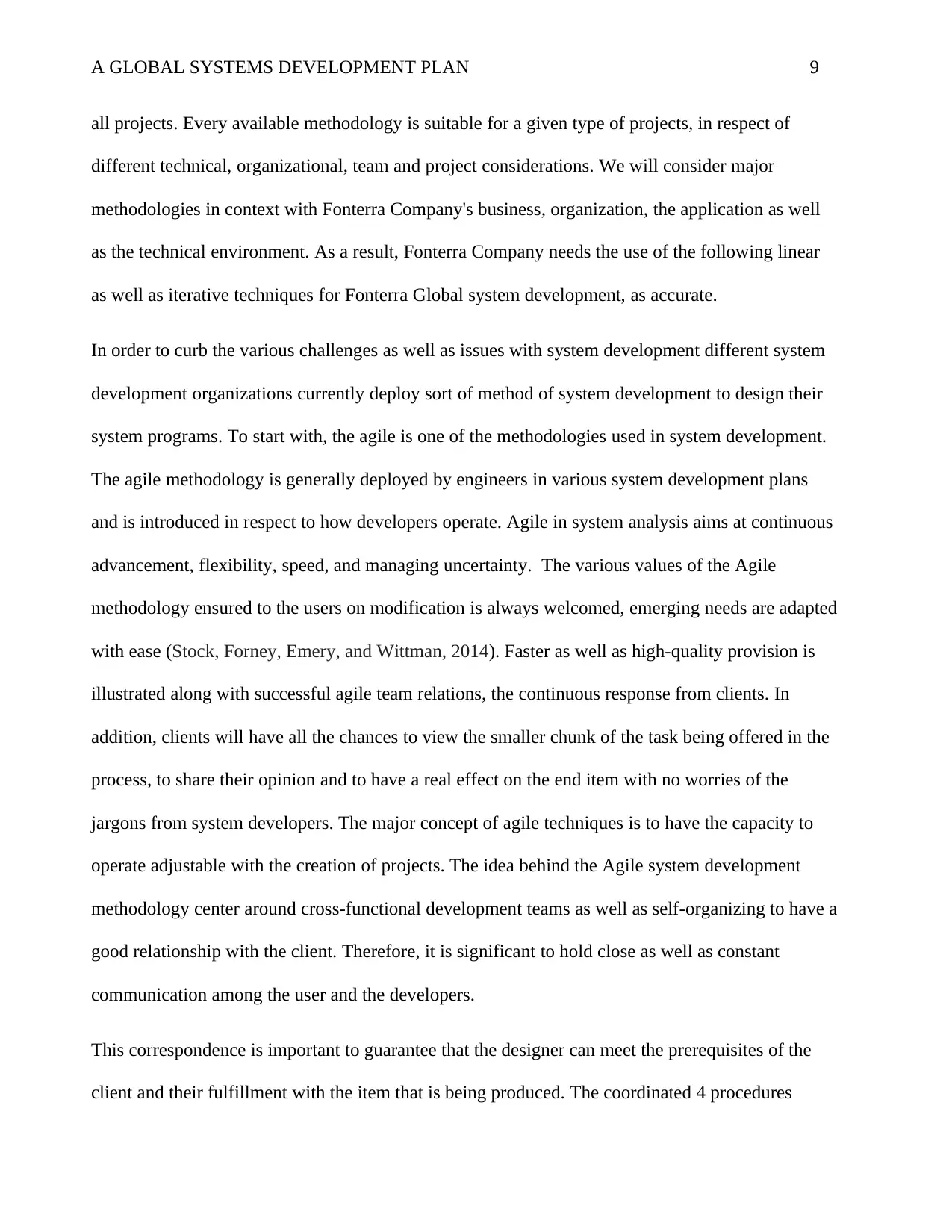
A GLOBAL SYSTEMS DEVELOPMENT PLAN 9
all projects. Every available methodology is suitable for a given type of projects, in respect of
different technical, organizational, team and project considerations. We will consider major
methodologies in context with Fonterra Company's business, organization, the application as well
as the technical environment. As a result, Fonterra Company needs the use of the following linear
as well as iterative techniques for Fonterra Global system development, as accurate.
In order to curb the various challenges as well as issues with system development different system
development organizations currently deploy sort of method of system development to design their
system programs. To start with, the agile is one of the methodologies used in system development.
The agile methodology is generally deployed by engineers in various system development plans
and is introduced in respect to how developers operate. Agile in system analysis aims at continuous
advancement, flexibility, speed, and managing uncertainty. The various values of the Agile
methodology ensured to the users on modification is always welcomed, emerging needs are adapted
with ease (Stock, Forney, Emery, and Wittman, 2014). Faster as well as high-quality provision is
illustrated along with successful agile team relations, the continuous response from clients. In
addition, clients will have all the chances to view the smaller chunk of the task being offered in the
process, to share their opinion and to have a real effect on the end item with no worries of the
jargons from system developers. The major concept of agile techniques is to have the capacity to
operate adjustable with the creation of projects. The idea behind the Agile system development
methodology center around cross-functional development teams as well as self-organizing to have a
good relationship with the client. Therefore, it is significant to hold close as well as constant
communication among the user and the developers.
This correspondence is important to guarantee that the designer can meet the prerequisites of the
client and their fulfillment with the item that is being produced. The coordinated 4 procedures
all projects. Every available methodology is suitable for a given type of projects, in respect of
different technical, organizational, team and project considerations. We will consider major
methodologies in context with Fonterra Company's business, organization, the application as well
as the technical environment. As a result, Fonterra Company needs the use of the following linear
as well as iterative techniques for Fonterra Global system development, as accurate.
In order to curb the various challenges as well as issues with system development different system
development organizations currently deploy sort of method of system development to design their
system programs. To start with, the agile is one of the methodologies used in system development.
The agile methodology is generally deployed by engineers in various system development plans
and is introduced in respect to how developers operate. Agile in system analysis aims at continuous
advancement, flexibility, speed, and managing uncertainty. The various values of the Agile
methodology ensured to the users on modification is always welcomed, emerging needs are adapted
with ease (Stock, Forney, Emery, and Wittman, 2014). Faster as well as high-quality provision is
illustrated along with successful agile team relations, the continuous response from clients. In
addition, clients will have all the chances to view the smaller chunk of the task being offered in the
process, to share their opinion and to have a real effect on the end item with no worries of the
jargons from system developers. The major concept of agile techniques is to have the capacity to
operate adjustable with the creation of projects. The idea behind the Agile system development
methodology center around cross-functional development teams as well as self-organizing to have a
good relationship with the client. Therefore, it is significant to hold close as well as constant
communication among the user and the developers.
This correspondence is important to guarantee that the designer can meet the prerequisites of the
client and their fulfillment with the item that is being produced. The coordinated 4 procedures
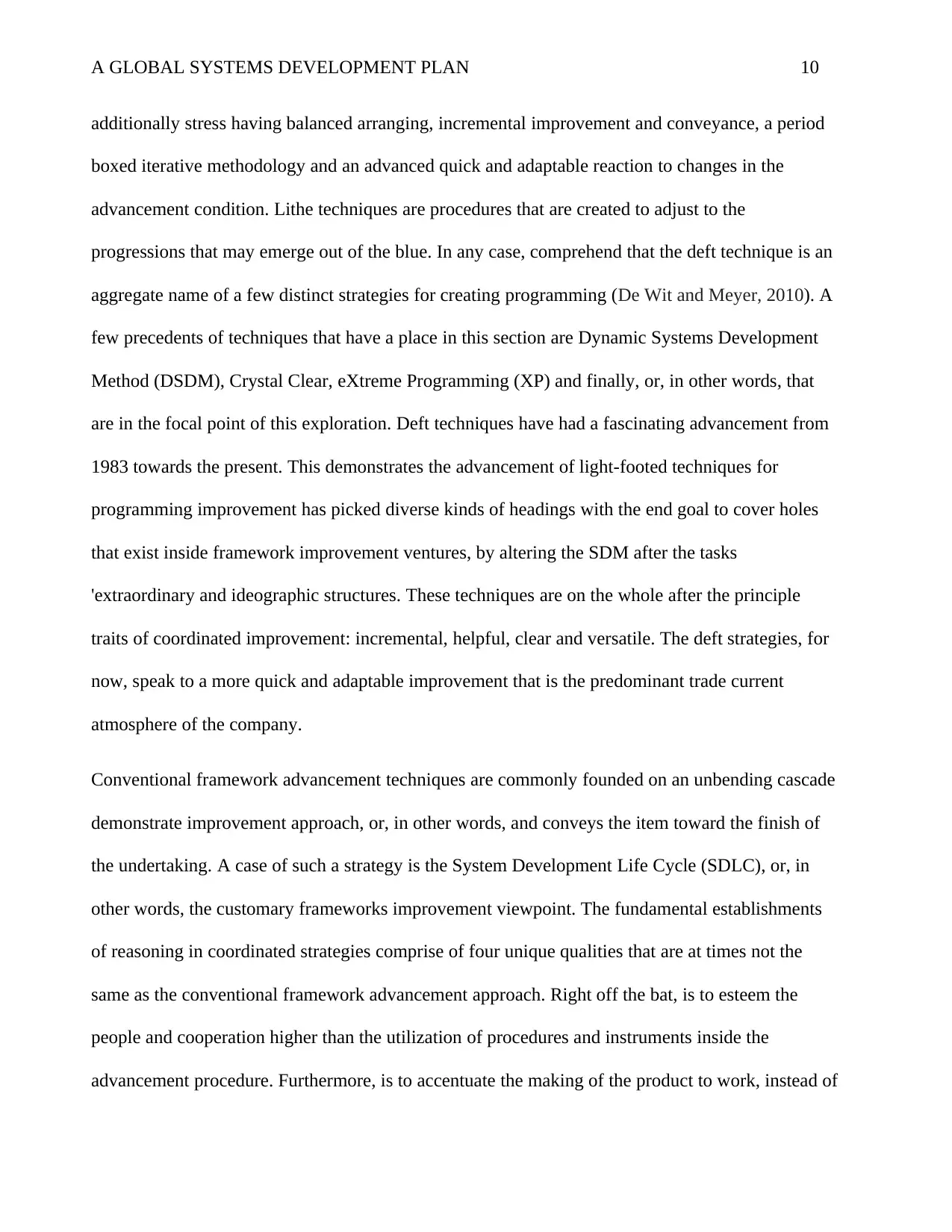
A GLOBAL SYSTEMS DEVELOPMENT PLAN 10
additionally stress having balanced arranging, incremental improvement and conveyance, a period
boxed iterative methodology and an advanced quick and adaptable reaction to changes in the
advancement condition. Lithe techniques are procedures that are created to adjust to the
progressions that may emerge out of the blue. In any case, comprehend that the deft technique is an
aggregate name of a few distinct strategies for creating programming (De Wit and Meyer, 2010). A
few precedents of techniques that have a place in this section are Dynamic Systems Development
Method (DSDM), Crystal Clear, eXtreme Programming (XP) and finally, or, in other words, that
are in the focal point of this exploration. Deft techniques have had a fascinating advancement from
1983 towards the present. This demonstrates the advancement of light-footed techniques for
programming improvement has picked diverse kinds of headings with the end goal to cover holes
that exist inside framework improvement ventures, by altering the SDM after the tasks
'extraordinary and ideographic structures. These techniques are on the whole after the principle
traits of coordinated improvement: incremental, helpful, clear and versatile. The deft strategies, for
now, speak to a more quick and adaptable improvement that is the predominant trade current
atmosphere of the company.
Conventional framework advancement techniques are commonly founded on an unbending cascade
demonstrate improvement approach, or, in other words, and conveys the item toward the finish of
the undertaking. A case of such a strategy is the System Development Life Cycle (SDLC), or, in
other words, the customary frameworks improvement viewpoint. The fundamental establishments
of reasoning in coordinated strategies comprise of four unique qualities that are at times not the
same as the conventional framework advancement approach. Right off the bat, is to esteem the
people and cooperation higher than the utilization of procedures and instruments inside the
advancement procedure. Furthermore, is to accentuate the making of the product to work, instead of
additionally stress having balanced arranging, incremental improvement and conveyance, a period
boxed iterative methodology and an advanced quick and adaptable reaction to changes in the
advancement condition. Lithe techniques are procedures that are created to adjust to the
progressions that may emerge out of the blue. In any case, comprehend that the deft technique is an
aggregate name of a few distinct strategies for creating programming (De Wit and Meyer, 2010). A
few precedents of techniques that have a place in this section are Dynamic Systems Development
Method (DSDM), Crystal Clear, eXtreme Programming (XP) and finally, or, in other words, that
are in the focal point of this exploration. Deft techniques have had a fascinating advancement from
1983 towards the present. This demonstrates the advancement of light-footed techniques for
programming improvement has picked diverse kinds of headings with the end goal to cover holes
that exist inside framework improvement ventures, by altering the SDM after the tasks
'extraordinary and ideographic structures. These techniques are on the whole after the principle
traits of coordinated improvement: incremental, helpful, clear and versatile. The deft strategies, for
now, speak to a more quick and adaptable improvement that is the predominant trade current
atmosphere of the company.
Conventional framework advancement techniques are commonly founded on an unbending cascade
demonstrate improvement approach, or, in other words, and conveys the item toward the finish of
the undertaking. A case of such a strategy is the System Development Life Cycle (SDLC), or, in
other words, the customary frameworks improvement viewpoint. The fundamental establishments
of reasoning in coordinated strategies comprise of four unique qualities that are at times not the
same as the conventional framework advancement approach. Right off the bat, is to esteem the
people and cooperation higher than the utilization of procedures and instruments inside the
advancement procedure. Furthermore, is to accentuate the making of the product to work, instead of
Secure Best Marks with AI Grader
Need help grading? Try our AI Grader for instant feedback on your assignments.
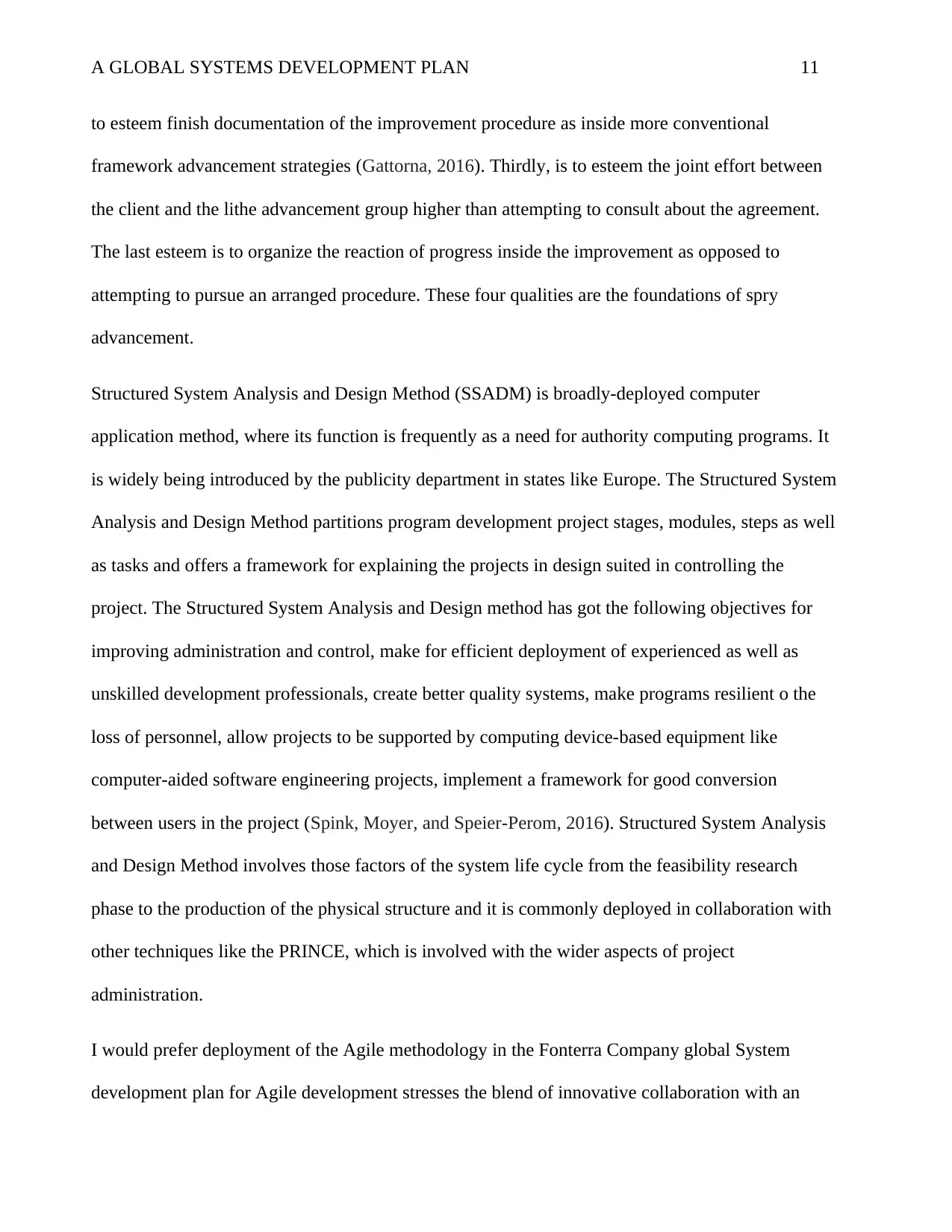
A GLOBAL SYSTEMS DEVELOPMENT PLAN 11
to esteem finish documentation of the improvement procedure as inside more conventional
framework advancement strategies (Gattorna, 2016). Thirdly, is to esteem the joint effort between
the client and the lithe advancement group higher than attempting to consult about the agreement.
The last esteem is to organize the reaction of progress inside the improvement as opposed to
attempting to pursue an arranged procedure. These four qualities are the foundations of spry
advancement.
Structured System Analysis and Design Method (SSADM) is broadly-deployed computer
application method, where its function is frequently as a need for authority computing programs. It
is widely being introduced by the publicity department in states like Europe. The Structured System
Analysis and Design Method partitions program development project stages, modules, steps as well
as tasks and offers a framework for explaining the projects in design suited in controlling the
project. The Structured System Analysis and Design method has got the following objectives for
improving administration and control, make for efficient deployment of experienced as well as
unskilled development professionals, create better quality systems, make programs resilient o the
loss of personnel, allow projects to be supported by computing device-based equipment like
computer-aided software engineering projects, implement a framework for good conversion
between users in the project (Spink, Moyer, and Speier-Perom, 2016). Structured System Analysis
and Design Method involves those factors of the system life cycle from the feasibility research
phase to the production of the physical structure and it is commonly deployed in collaboration with
other techniques like the PRINCE, which is involved with the wider aspects of project
administration.
I would prefer deployment of the Agile methodology in the Fonterra Company global System
development plan for Agile development stresses the blend of innovative collaboration with an
to esteem finish documentation of the improvement procedure as inside more conventional
framework advancement strategies (Gattorna, 2016). Thirdly, is to esteem the joint effort between
the client and the lithe advancement group higher than attempting to consult about the agreement.
The last esteem is to organize the reaction of progress inside the improvement as opposed to
attempting to pursue an arranged procedure. These four qualities are the foundations of spry
advancement.
Structured System Analysis and Design Method (SSADM) is broadly-deployed computer
application method, where its function is frequently as a need for authority computing programs. It
is widely being introduced by the publicity department in states like Europe. The Structured System
Analysis and Design Method partitions program development project stages, modules, steps as well
as tasks and offers a framework for explaining the projects in design suited in controlling the
project. The Structured System Analysis and Design method has got the following objectives for
improving administration and control, make for efficient deployment of experienced as well as
unskilled development professionals, create better quality systems, make programs resilient o the
loss of personnel, allow projects to be supported by computing device-based equipment like
computer-aided software engineering projects, implement a framework for good conversion
between users in the project (Spink, Moyer, and Speier-Perom, 2016). Structured System Analysis
and Design Method involves those factors of the system life cycle from the feasibility research
phase to the production of the physical structure and it is commonly deployed in collaboration with
other techniques like the PRINCE, which is involved with the wider aspects of project
administration.
I would prefer deployment of the Agile methodology in the Fonterra Company global System
development plan for Agile development stresses the blend of innovative collaboration with an
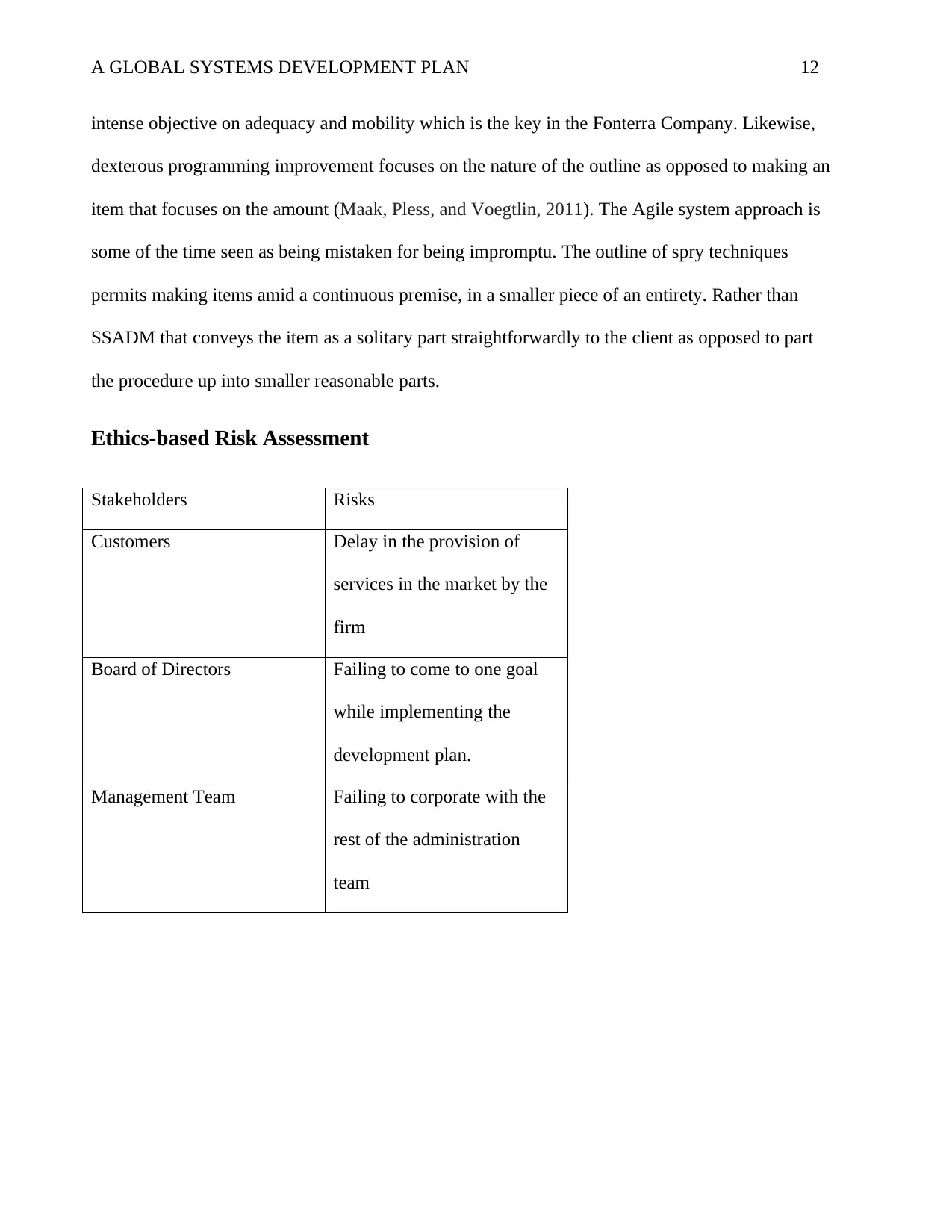
A GLOBAL SYSTEMS DEVELOPMENT PLAN 12
intense objective on adequacy and mobility which is the key in the Fonterra Company. Likewise,
dexterous programming improvement focuses on the nature of the outline as opposed to making an
item that focuses on the amount (Maak, Pless, and Voegtlin, 2011). The Agile system approach is
some of the time seen as being mistaken for being impromptu. The outline of spry techniques
permits making items amid a continuous premise, in a smaller piece of an entirety. Rather than
SSADM that conveys the item as a solitary part straightforwardly to the client as opposed to part
the procedure up into smaller reasonable parts.
Ethics-based Risk Assessment
Stakeholders Risks
Customers Delay in the provision of
services in the market by the
firm
Board of Directors Failing to come to one goal
while implementing the
development plan.
Management Team Failing to corporate with the
rest of the administration
team
intense objective on adequacy and mobility which is the key in the Fonterra Company. Likewise,
dexterous programming improvement focuses on the nature of the outline as opposed to making an
item that focuses on the amount (Maak, Pless, and Voegtlin, 2011). The Agile system approach is
some of the time seen as being mistaken for being impromptu. The outline of spry techniques
permits making items amid a continuous premise, in a smaller piece of an entirety. Rather than
SSADM that conveys the item as a solitary part straightforwardly to the client as opposed to part
the procedure up into smaller reasonable parts.
Ethics-based Risk Assessment
Stakeholders Risks
Customers Delay in the provision of
services in the market by the
firm
Board of Directors Failing to come to one goal
while implementing the
development plan.
Management Team Failing to corporate with the
rest of the administration
team
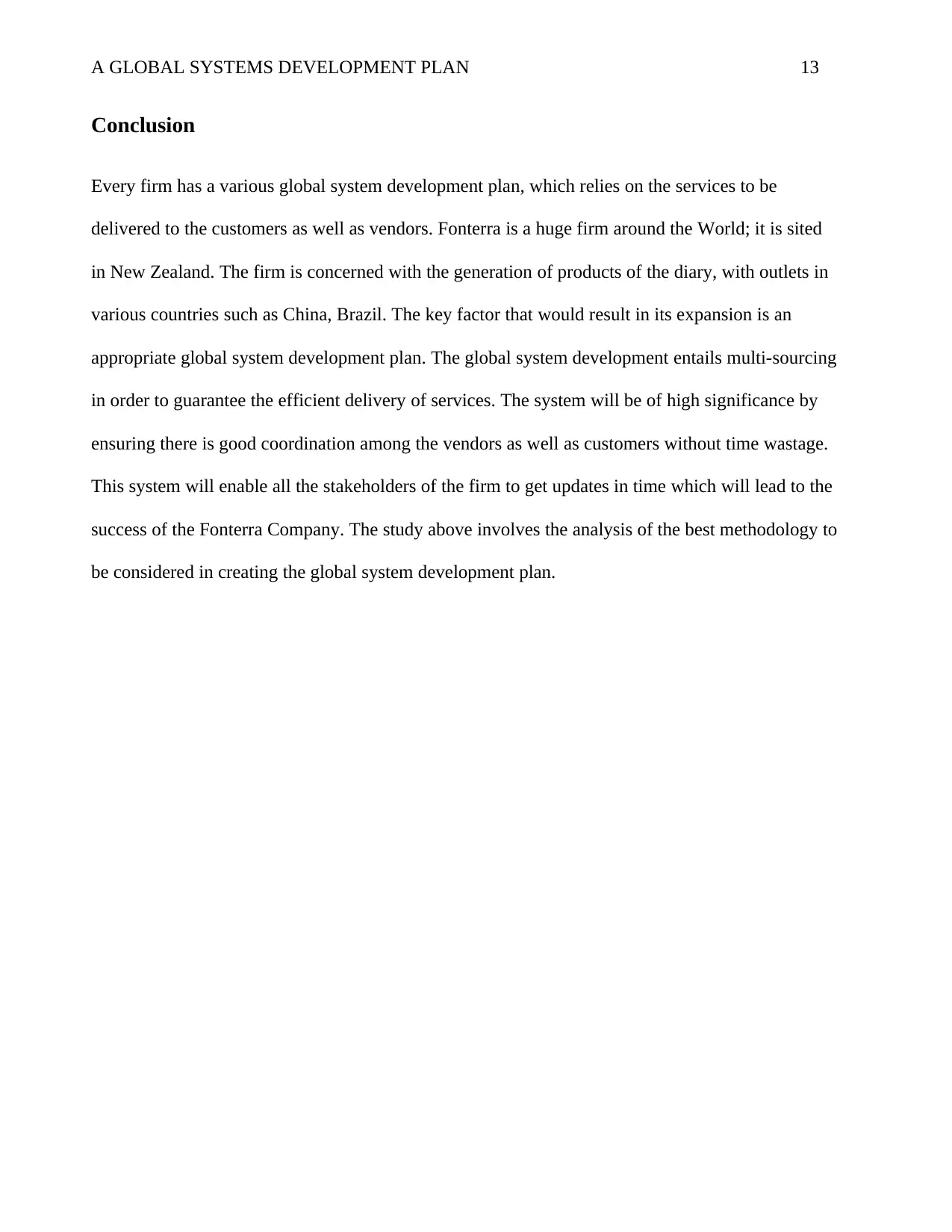
A GLOBAL SYSTEMS DEVELOPMENT PLAN 13
Conclusion
Every firm has a various global system development plan, which relies on the services to be
delivered to the customers as well as vendors. Fonterra is a huge firm around the World; it is sited
in New Zealand. The firm is concerned with the generation of products of the diary, with outlets in
various countries such as China, Brazil. The key factor that would result in its expansion is an
appropriate global system development plan. The global system development entails multi-sourcing
in order to guarantee the efficient delivery of services. The system will be of high significance by
ensuring there is good coordination among the vendors as well as customers without time wastage.
This system will enable all the stakeholders of the firm to get updates in time which will lead to the
success of the Fonterra Company. The study above involves the analysis of the best methodology to
be considered in creating the global system development plan.
Conclusion
Every firm has a various global system development plan, which relies on the services to be
delivered to the customers as well as vendors. Fonterra is a huge firm around the World; it is sited
in New Zealand. The firm is concerned with the generation of products of the diary, with outlets in
various countries such as China, Brazil. The key factor that would result in its expansion is an
appropriate global system development plan. The global system development entails multi-sourcing
in order to guarantee the efficient delivery of services. The system will be of high significance by
ensuring there is good coordination among the vendors as well as customers without time wastage.
This system will enable all the stakeholders of the firm to get updates in time which will lead to the
success of the Fonterra Company. The study above involves the analysis of the best methodology to
be considered in creating the global system development plan.
Paraphrase This Document
Need a fresh take? Get an instant paraphrase of this document with our AI Paraphraser
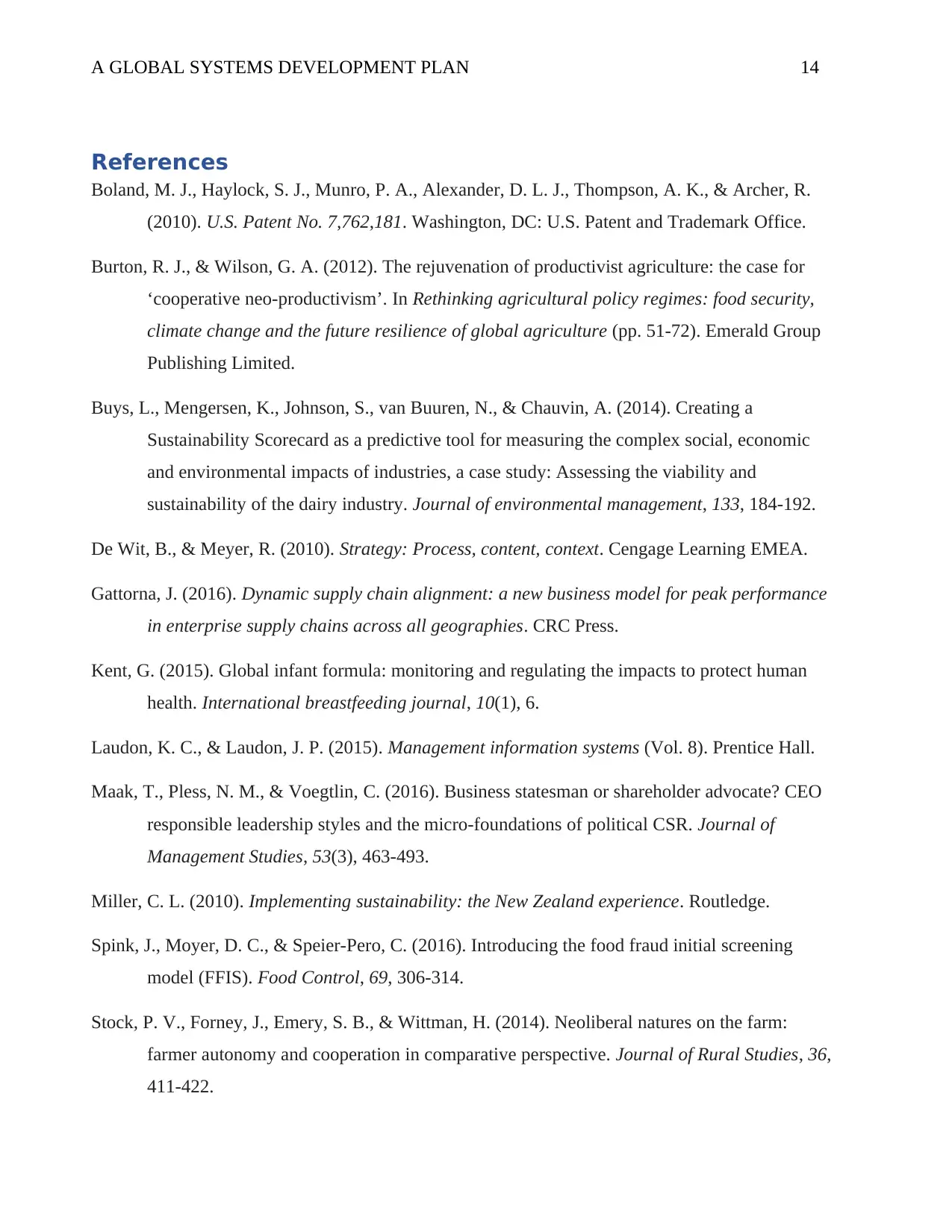
A GLOBAL SYSTEMS DEVELOPMENT PLAN 14
References
Boland, M. J., Haylock, S. J., Munro, P. A., Alexander, D. L. J., Thompson, A. K., & Archer, R.
(2010). U.S. Patent No. 7,762,181. Washington, DC: U.S. Patent and Trademark Office.
Burton, R. J., & Wilson, G. A. (2012). The rejuvenation of productivist agriculture: the case for
‘cooperative neo-productivism’. In Rethinking agricultural policy regimes: food security,
climate change and the future resilience of global agriculture (pp. 51-72). Emerald Group
Publishing Limited.
Buys, L., Mengersen, K., Johnson, S., van Buuren, N., & Chauvin, A. (2014). Creating a
Sustainability Scorecard as a predictive tool for measuring the complex social, economic
and environmental impacts of industries, a case study: Assessing the viability and
sustainability of the dairy industry. Journal of environmental management, 133, 184-192.
De Wit, B., & Meyer, R. (2010). Strategy: Process, content, context. Cengage Learning EMEA.
Gattorna, J. (2016). Dynamic supply chain alignment: a new business model for peak performance
in enterprise supply chains across all geographies. CRC Press.
Kent, G. (2015). Global infant formula: monitoring and regulating the impacts to protect human
health. International breastfeeding journal, 10(1), 6.
Laudon, K. C., & Laudon, J. P. (2015). Management information systems (Vol. 8). Prentice Hall.
Maak, T., Pless, N. M., & Voegtlin, C. (2016). Business statesman or shareholder advocate? CEO
responsible leadership styles and the micro‐foundations of political CSR. Journal of
Management Studies, 53(3), 463-493.
Miller, C. L. (2010). Implementing sustainability: the New Zealand experience. Routledge.
Spink, J., Moyer, D. C., & Speier-Pero, C. (2016). Introducing the food fraud initial screening
model (FFIS). Food Control, 69, 306-314.
Stock, P. V., Forney, J., Emery, S. B., & Wittman, H. (2014). Neoliberal natures on the farm:
farmer autonomy and cooperation in comparative perspective. Journal of Rural Studies, 36,
411-422.
References
Boland, M. J., Haylock, S. J., Munro, P. A., Alexander, D. L. J., Thompson, A. K., & Archer, R.
(2010). U.S. Patent No. 7,762,181. Washington, DC: U.S. Patent and Trademark Office.
Burton, R. J., & Wilson, G. A. (2012). The rejuvenation of productivist agriculture: the case for
‘cooperative neo-productivism’. In Rethinking agricultural policy regimes: food security,
climate change and the future resilience of global agriculture (pp. 51-72). Emerald Group
Publishing Limited.
Buys, L., Mengersen, K., Johnson, S., van Buuren, N., & Chauvin, A. (2014). Creating a
Sustainability Scorecard as a predictive tool for measuring the complex social, economic
and environmental impacts of industries, a case study: Assessing the viability and
sustainability of the dairy industry. Journal of environmental management, 133, 184-192.
De Wit, B., & Meyer, R. (2010). Strategy: Process, content, context. Cengage Learning EMEA.
Gattorna, J. (2016). Dynamic supply chain alignment: a new business model for peak performance
in enterprise supply chains across all geographies. CRC Press.
Kent, G. (2015). Global infant formula: monitoring and regulating the impacts to protect human
health. International breastfeeding journal, 10(1), 6.
Laudon, K. C., & Laudon, J. P. (2015). Management information systems (Vol. 8). Prentice Hall.
Maak, T., Pless, N. M., & Voegtlin, C. (2016). Business statesman or shareholder advocate? CEO
responsible leadership styles and the micro‐foundations of political CSR. Journal of
Management Studies, 53(3), 463-493.
Miller, C. L. (2010). Implementing sustainability: the New Zealand experience. Routledge.
Spink, J., Moyer, D. C., & Speier-Pero, C. (2016). Introducing the food fraud initial screening
model (FFIS). Food Control, 69, 306-314.
Stock, P. V., Forney, J., Emery, S. B., & Wittman, H. (2014). Neoliberal natures on the farm:
farmer autonomy and cooperation in comparative perspective. Journal of Rural Studies, 36,
411-422.
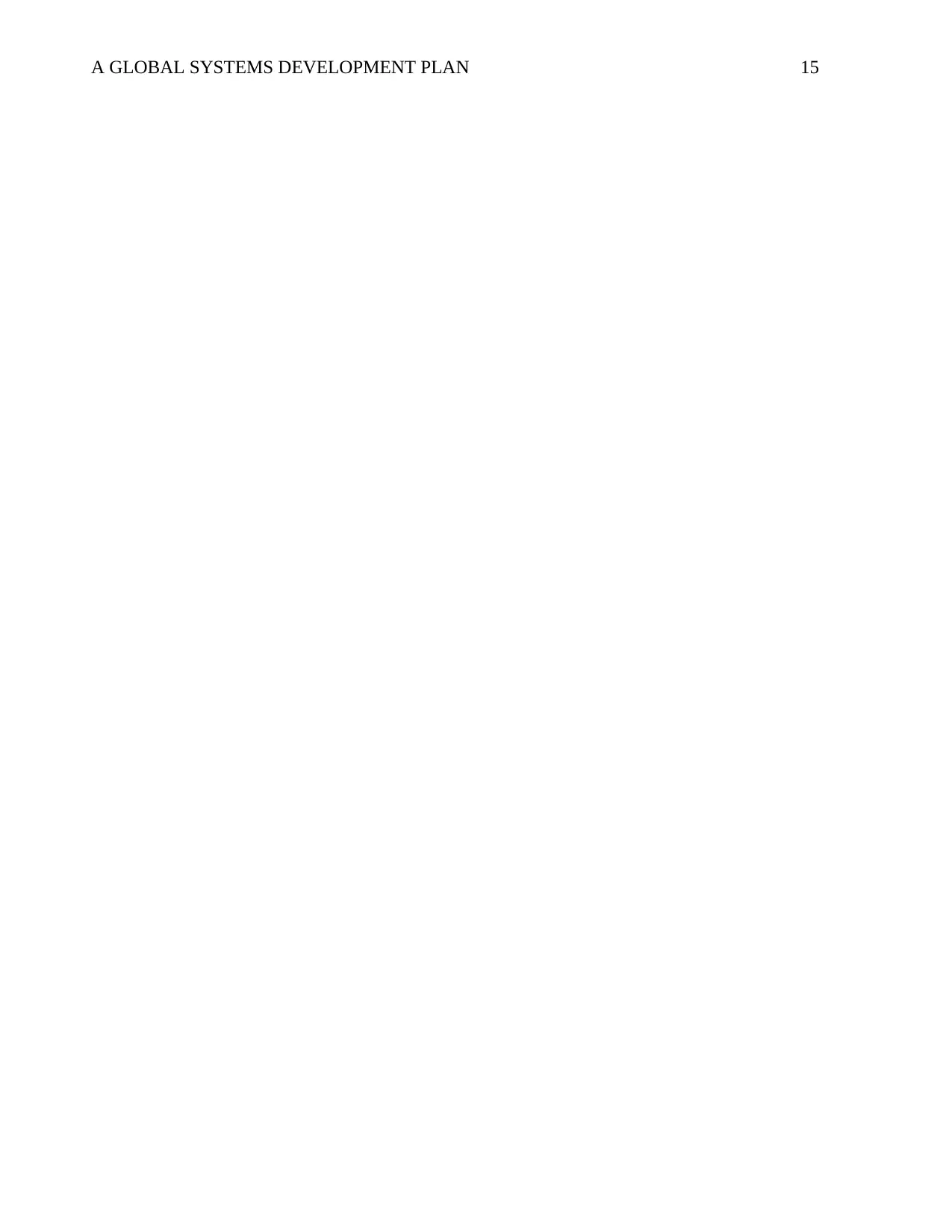
A GLOBAL SYSTEMS DEVELOPMENT PLAN 15
1 out of 15
Your All-in-One AI-Powered Toolkit for Academic Success.
+13062052269
info@desklib.com
Available 24*7 on WhatsApp / Email
![[object Object]](/_next/static/media/star-bottom.7253800d.svg)
Unlock your academic potential
© 2024 | Zucol Services PVT LTD | All rights reserved.




